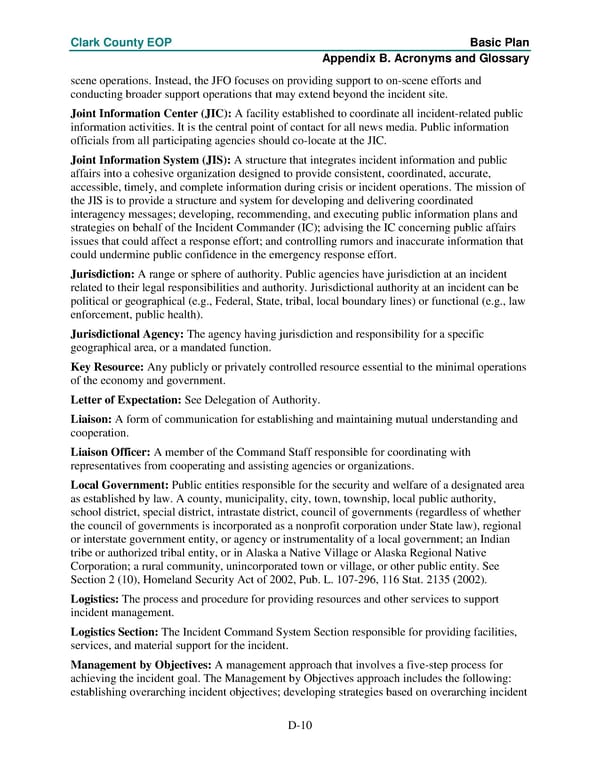Clark County EOP Basic Plan Appendix B. Acronyms and Glossary scene operations. Instead, the JFO focuses on providing support to on-scene efforts and conducting broader support operations that may extend beyond the incident site. Joint Information Center (JIC): A facility established to coordinate all incident-related public information activities. It is the central point of contact for all news media. Public information officials from all participating agencies should co-locate at the JIC. Joint Information System (JIS): A structure that integrates incident information and public affairs into a cohesive organization designed to provide consistent, coordinated, accurate, accessible, timely, and complete information during crisis or incident operations. The mission of the JIS is to provide a structure and system for developing and delivering coordinated interagency messages; developing, recommending, and executing public information plans and strategies on behalf of the Incident Commander (IC); advising the IC concerning public affairs issues that could affect a response effort; and controlling rumors and inaccurate information that could undermine public confidence in the emergency response effort. Jurisdiction: A range or sphere of authority. Public agencies have jurisdiction at an incident related to their legal responsibilities and authority. Jurisdictional authority at an incident can be political or geographical (e.g., Federal, State, tribal, local boundary lines) or functional (e.g., law enforcement, public health). Jurisdictional Agency: The agency having jurisdiction and responsibility for a specific geographical area, or a mandated function. Key Resource: Any publicly or privately controlled resource essential to the minimal operations of the economy and government. Letter of Expectation: See Delegation of Authority. Liaison: A form of communication for establishing and maintaining mutual understanding and cooperation. Liaison Officer: A member of the Command Staff responsible for coordinating with representatives from cooperating and assisting agencies or organizations. Local Government: Public entities responsible for the security and welfare of a designated area as established by law. A county, municipality, city, town, township, local public authority, school district, special district, intrastate district, council of governments (regardless of whether the council of governments is incorporated as a nonprofit corporation under State law), regional or interstate government entity, or agency or instrumentality of a local government; an Indian tribe or authorized tribal entity, or in Alaska a Native Village or Alaska Regional Native Corporation; a rural community, unincorporated town or village, or other public entity. See Section 2 (10), Homeland Security Act of 2002, Pub. L. 107-296, 116 Stat. 2135 (2002). Logistics: The process and procedure for providing resources and other services to support incident management. Logistics Section: The Incident Command System Section responsible for providing facilities, services, and material support for the incident. Management by Objectives: A management approach that involves a five-step process for achieving the incident goal. The Management by Objectives approach includes the following: establishing overarching incident objectives; developing strategies based on overarching incident D-10
 Emergency Operations Plan Page 113 Page 115
Emergency Operations Plan Page 113 Page 115